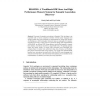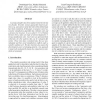1998 search results - page 101 / 400 » Basic Association Rules |
SYNASC
2005
IEEE
14 years 3 months ago
2005
IEEE
— A framework that describes the evolution of P systems with bounded parallelism is defined by introducing basic formal features that can be then integrated into a structural op...
SEMWEB
2005
Springer
14 years 3 months ago
2005
Springer
Discovery of semantic associations in Semantic Web ontologies is an important task in various analytical activities. Several query languages and storage systems have been designed ...
NPL
2002
13 years 9 months ago
2002
A neural network model of associative memory is presented which unifies the two historically more relevant enhancements to the basic Little-Hopfield discrete model: the graded resp...
JUCS
2010
13 years 8 months ago
2010
: One of the success factors of Work Integrated Learning (WIL) is to provide the appropriate content to the users, both suitable for the topics they are currently working on, and t...
ICDIM
2007
IEEE
14 years 4 months ago
2007
IEEE
Learning classifiers has been studied extensively the last two decades. Recently, various approaches based on patterns (e.g., association rules) that hold within labeled data hav...


